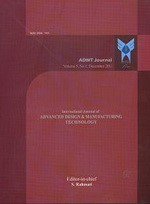-
-
List of Articles
-
Open Access Article
1 - Analytical Solution and Simulation of Flexible Joint in Thrust Vector Control System under Bending
Ebrahim Harirbafan MOhsen Mohseni Shakib AliAkbar Karimi Mojtaba Heydari -
Open Access Article
2 - Design and Manufacturing Electrochemical Jet Turning Machine and Investigation of its Effective Parameters
Amin Mirahamadi Nader Sharafi -
Open Access Article
3 - Dynamic Analysis and Path Control of a Snake Like Robot
Navid Negahbani Mostafa Ghayour -
Open Access Article
4 - Investigation of Machining Parameters in Wire Electrical Discharge Machining (WEDM) on the Surface Roughness & Cutting Speed of Tungsten Carbide
Mehdi Jafarian GholamHosein Dehghan Abbas Vafaeisefat -
Open Access Article
5 - Two-Phase Heat Transfer and Pressure Drop of Carbon Dioxide in Pipes
Zahara Baniamerian Cirus Aghanajafi -
Open Access Article
6 - Analysis and Optimization of Reducing Steady State Time for Heating Systems
Farhad Talebi Sayed Mehdi Sayed Nasrollah Fatemeh Yousefi -
Open Access Article
7 - Application of the Inverse Heat Conduction Method in Identifying a Cavity Inside Materials
MohamadMehdi Mizanadl Mohsen Dashti Mahmoud Khodadad -
Open Access Article
8 - Vibration Analysis and Design of Dynamic Absorber in a Vertical Drilling Machine
MohamadReza Elhami Mojtaba Heydari
-
The rights to this website are owned by the Raimag Press Management System.
Copyright © 2021-2025







